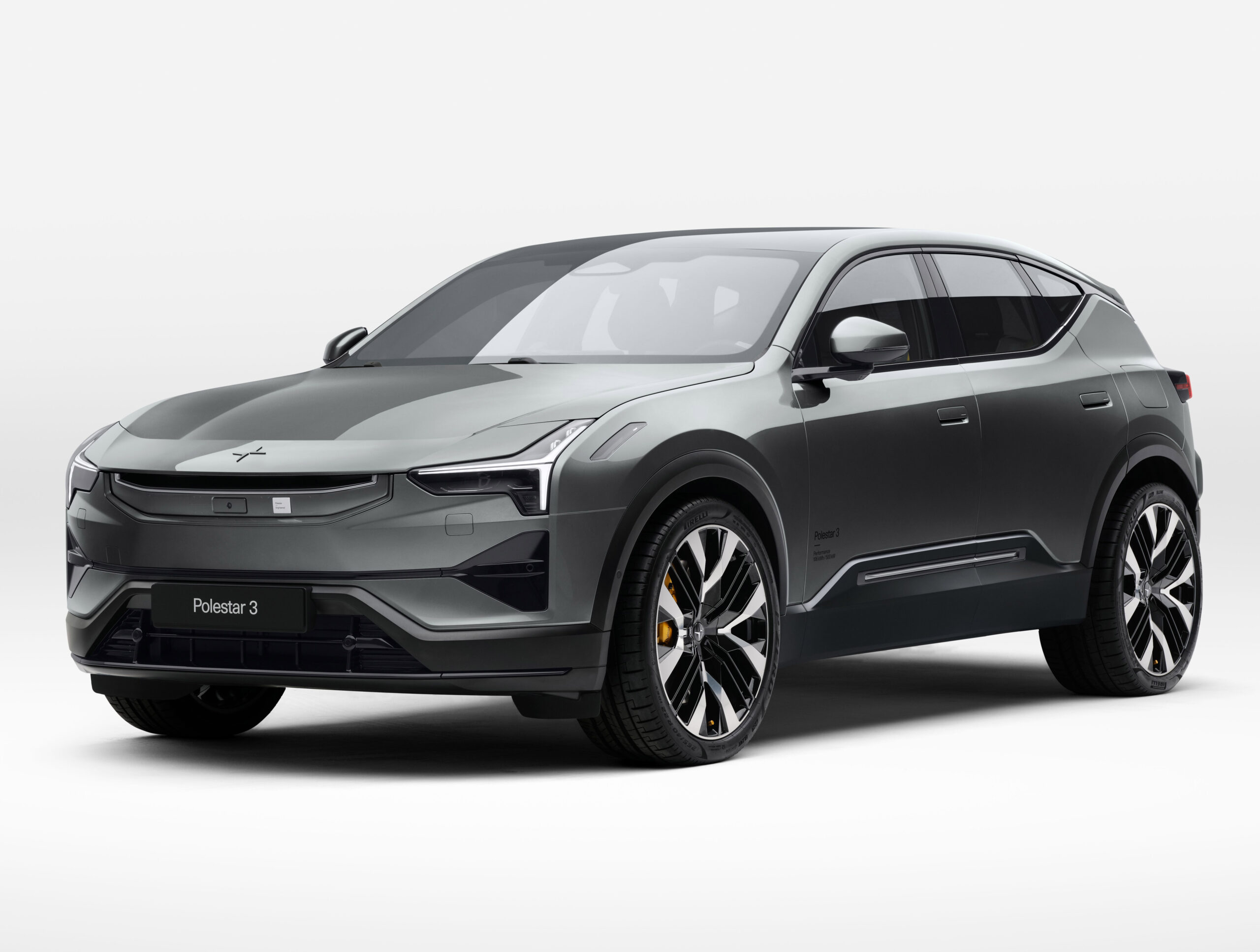

The Toyota Crown returns for 2023 as a family of vehicles that represents a more luxurious side of the brand, without treading on Lexus waters. Presented as a long, low-slung rear-wheel drive sedan (Crown Sedan), a sporty hatchback (Crown Sport), a more traditional station wagon type (Crown Estate), and a taller and funkier sedan (Crown Crossover), the latter is currently the only one confirmed for a North American release. That’s the one we just got to drive, and it is an interesting proposition for those who will be looking for an Avalon in Toyota showrooms but can no longer find it.
In the photo below, you’ll see the Crown we are getting here, the ‘Crossover’ type, in the front row. North American markets will simply call this the Crown for now and will see a Toyota logo on the hood, not the Crown logo found on the car in Japan for the last 70 years. With a four-door coupe shape and a taller stance (plus the fact that Toyota calls it the Crossover), you wouldn’t be crazy for assuming that there is a liftback trunk opening or substantial ground clearance compared to a regular old Camry. We have since learned that ground clearance is actually only two tenths of an inch higher, while the roof is actually four inches higher than that model. That’s no liftback back there, either, just a simple sedan trunk. Long story short, the Crown is a sedan in the most traditional sense. The difference between it and other sedans in Toyota’s lineup comes down to powertrain details, which I will cover momentarily.
If you spring for the Platinum grade, Toyota will offer a ‘Bi-tone’ paint option. Available in brown, white, red and silver, this scheme places a contrasting black stripe from the nose all the way to the bottom of the trunk opening. It works better in some colors than others, though no matter which color you choose, the black hood is a little too much in our opinion. Out back, opinions are split on the black treatment of the trunk lid and surrounding areas. There is no denying that the Crown is an interesting thing to look at, but whether it is too shocking for the typical Avalon shopper remains to be seen.

If you’re curious to see the Crown without the Bi-tone paint, take a gander below. Other interesting things about this design include the first application of 21-inch wheels on a Toyota sedan ever, the ridged surface on the trim where the trunk release button lives (or hides, honestly), and the Porsche Macan-like black side rocker moldings.

The term ‘full-size sedan’ does not mean what it used to. Like the current Nissan Maxima and the late Avalon, the Crown is not massively different when it comes to interior dimensions compared to its mid-size sibling, despite having a larger exterior footprint. Because the hip point rose with the ceiling, head room is not noticeably different from the Camry’s up front. You may even feel a little more cramped in the rear depending on how you prefer to sit or how tall you are. It isn’t a deal-breaker though, even with the panoramic moonroof on the Platinum grade we spent most of our time in.

In regards to the design, there is a new steering wheel as well as a more horizontal approach compared to the Avalon’s. The materials are not top-notch or Lexus-like in any way, sitting perfectly in the mix with the nicest Toyotas you can currently purchase. The new Audio Multimedia system powers the 12-inch main display and the impressive full-LCD instrument cluster. This is the one area where the Crown presents itself as more upscale or expensive than anything from Lexus, as the largest instrument cluster you’ll find in that lineup is 7 inches. This is also the first application to implement a small map display in the center of the cluster, a welcome addition even if it doesn’t take up the majority of the screen. Something else the Avalon never had (but the Camry surprisingly does)? A panoramic moonroof. It doesn’t open up, but at least there is a power-operated sun shade.

The Crown comes to America exclusively as a hybrid with all-wheel drive. The base hybrid system found on XLE and Limited trims is the THS 2.5L 4-cylinder found in the Camry, RAV4, and many other current Toyota hybrids. Paired with Toyota’s planetary gear set transmission, it produces 236 horsepower and manages an impressive 41 mpg combined. If you’re looking for a more powerful and engaging experience, the Platinum trim comes exclusively with the all-new Hybrid MAX system. Combining a 2.4L turbocharged 4-cylinder (same one found in the 2023 Highlander), a six-speed automatic, a front electric motor, and a rear-mounted eAxle electric motor, it produces 340 horsepower and nets 30 mpg combined. Just like it is in the Lexus RX500h F Sport Performance, this is definitely the fastest one. The sprint to 60 mph should take around 5.7 seconds, according to Toyota.

One limiting factor holding the Crown back is its curb weight. No matter which hybrid you choose, the Crown weighs more than a V8 Dodge Challenger – around 4,300 pounds.
With all-wheel drive standard, the standard Crown doesn’t feel as much like the Camry Hybrid as you’d expect. Floor it in a corner, you won’t find as much torque steer because some of the power gets sent to the rear axle, helping it feel more sorted in corners. 0-60 mph will not be as swift as some of the competition because we find much less horsepower here than in competition such as the Kia Stinger. The feel behind the steering wheel is not too far off of something like a Nissan Maxima because that car has a real CVT. This planetary gear set feels like a CVT, but isn’t actually a CVT. 60-0 mph stopping distances are likely going to be a bit long for this segment, since as I mentioned earlier, this one weighs nearly 4,300 pounds. The model with the Hybrid Max system weighs just over 4,300 pounds, and all models have 225-mm tires. We wouldn’t be surprised if the stopping distance on this model was upwards of 125-130 feet.
On the other hand, that curb weight helps this feel like a more traditional American sedan in a way. If you’re looking for something that’s more comfortable to ride in, the Crown will certainly fit the bill. This suspension, combined with the higher curb weight, helps soak up the bumps and feels very smooth out on rougher road surfaces or open highways. You will notice that the base hybrid system does have a bit more noise in the cabin than something like a Lexus ES Hybrid. That’s all thanks to more sound-deadening materials implemented in the Lexus. As far as handling dynamics, the Crown does feel pretty well sorted like other front-wheel drive Toyota platforms.
Now, let’s talk about the new hybrid system. The Hybrid Max is significantly faster than the standard hybrid and may even be a bit faster than Toyota’s 5.7-second estimate for 0-60 mph. With over 300 horsepower and 400 lb.-ft. of torque, there is a lot more power going to the rear, up to 80% of torque to that rear axle. If you make a sharp right turn and floor it, you’ll notice that the rear end swings out a little bit. If you’re familiar with some of the luxury options available in the U.S. right now, you’ll probably agree that this feels more like a Volvo plug-in hybrid than a traditional Toyota or Lexus. It’s not going to turn into a Ford Mustang or anything like that, but it is going to have a really solid feel to it. With that six-speed automatic transmission under the hood, this is also going to feel more traditional than the standard hybrid. It actually feels a little bit like a dual-clutch transmission now and then because it doesn’t have a torque converter. Instead, it has a wet clutch separating the transmission from the engine, so shifts are pretty smooth and pretty quick.
Both hybrid systems have pretty comparable road noise isolation. Wind noises are well controlled too, but you definitely get more engine noise in the cabin than the base hybrid system. This system’s regenerative breaking doesn’t seem to be quite as aggressive, likely due to the design. During braking, the transmission downshifts chronologically until you come to a complete stop, very similar a Hyundai or Kia hybrid system. There’s one important difference, however. The rear electric motor, which is also doing some of the regen braking, seems to be helping make those shifts a little bit less noticeable.

Platinum
If you’re interested in the Toyota Crown, you have a pretty tough decision ahead of you. Do you get the base hybrid system that’s really focused on efficiency, or do you get the more performance-oriented Hybrid Max in the top-end Platinum trim? If you want the latter, you have to pay the most amount of money. The Platinum starts at $52,350 and receives the Bi-tone paint options and 21″ wheels. The base XLE trim starts at $39,950 and gives you the 12.3″ infotainment screen, LED headlights, Toyota Safety Sense 3.0, a Qi wireless charge pad, and heated front seats. The mid-level Limited trim starts at $45,550 and gives you the panoramic moonroof, rain-sensing wipers, dual-zone auto climate, and leather seats.
The Crown appears to be an interesting entry in a world where car companies are better off introducing more crossovers. It certainly isn’t one of those, but it may just be different enough to entice sedan buyers back to the dealerships. With a plug-in hybrid Prime variant on the way, there is no denying that Toyota wants to give customers options, too. Until we get the Crown at home to test for a week, color us intrigued.



